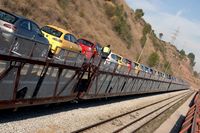More Than 63,300 Vehicles Transported Between Seat And Port Of Barcelona
MARTORELL, Spain – January 19, 2009: The rail link for vehicle transport between the SEAT factory in Martorell and the Port of Barcelona, opened just one year ago, has carried a total number of 63,305 cars up until December 31st. Since January 18th – when the joint-venture company Autometro started up the rail link – to the end of last year, a total number of 394 shipments have been made between the Spanish manufacturer’s production plant and the port area. Activity was at its highest in July, when a total number of 49 shipments carried 8,466 cars manufactured at the SEAT plant.
This rail link has made a very significant contribution to the reduction of road congestion, having taken some 20,000 lorries off the Catalan roads, entailing a proportional reduction of CO2 emissions. The rail link between the SEAT plant and the port is the result of the commitment made by the different stakeholders with a view to encouraging sustainable transport, and giving priority to the train as an environmentally-friendly, reliable and efficient mode of transport.
The link, providing an average of two shipments per day, comprises a 38 double-decker carriage convoy, 411 metres in length, which can transport some 171 vehicles at a time.
During its first year, the project was full up and running, and has received acclaim from different quarters, such as the best logistics idea at the recent International Logistics Fair (SIL), or else the award given to SEAT as outstanding loader by the Loaders’ Circle of the Port of Barcelona.
The project began in November 2005 with the creation of the joint-venture company Autometro – comprising the Ferrocarrils de la Generalitat de Catalunya (FGC) local rail company, COMSA Rail Transport and Pecovasa – with the aim of managing the transport of SEAT vehicles between the Martorell plant and the Port of Barcelona.
Setting up the railroad service was financed by an investment of 6.8 million euros, the result of collaboration between the Catalan government, the Port of Barcelona, and SEAT. The link used the FGC’s Llobregat-Anoia line between Igualada and Barcelona, which was adapted by adding a branch line leading to the SEAT factory, coupled with new track providing access to the unloading area of the Port.
Extension of service
In the short run, the stakeholders are looking at the possibility of
extending the service by providing vehicle transport from the Martorell
plant to the new facilities at the Moll Costa wharf, currently being
enlarged to accommodate a short-sea shipping (SSS) terminal.
SEAT’s aim is to ship some 20,000 vehicles a year to this wharf, where they will arrive by rail for onward shipment to Italy. Rail transport of such volumes will enable an additional reduction of lorries on the roads and will help to decongest the northern access to the Port of Barcelona, an area with high concentrations of heavy goods vehicles.
The rail link project to Martorell thus contributes to the materialization of one of the Port of Barcelona’s strategic objectives, which is to increase the share of goods transported to the port area by rail. The Port’s aim is to have 30% of incoming and outgoing cargo on board a train; this aim will be achievable once the Rail and Road Access Plan to the Port of Barcelona, promoted by the Spanish Ministry of Public Works, has been implemented.



